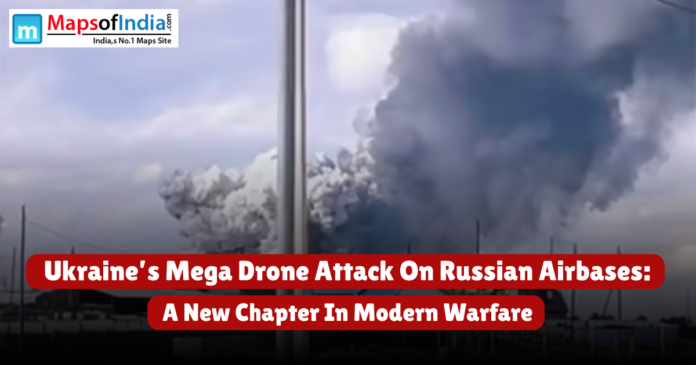Introduction
Ukraine began the “Operation Spider’s Web” on June 1, 2025, which was one of their boldest and most extensive drone operations during the war. A well-planned attack endeavoured to hit five Russian military airbases that were positioned inside the country, for example Olenya, Dyagilevo, Ivanovo Severny, Belaya and Ukrainka. The action led to the loss of over 40 military aircraft which included large bombers such as Tu-95 and Tu-22M3, as well as an A-50 aircraft for detecting enemy attacks and coordinating defenses.
Strategic Execution and Planning
After 18 months of preparations, Ukraine’s Security Service (SBU) executed the operation. Drones were sent secretly to Russia and put inside fake cargo loaded onto trucks. Mobile launch platforms were set up by the U.S. military close to the airbases to be attacked. On command, the roofs of the containers were opened to let the drones go out and aim at their targets accurately.
Impact on Russian Military Capabilities
As a result of drone strikes, Russia’s options for range attacks by air were greatly limited. Around one-third of Russia’s cruise missile carriers were damaged, and damages are expected to cost more than $7 billion. An example is the Tu-95, which is no longer produced, so its destruction cannot be easily replaced.
Russian Response and International Repercussions
Despite the attacks, the Russian Ministry of Defense stated that they were contained and, in some cases, were not successful. Still, photos from space and independent sources showed that a lot of damage occurred at airbases. Some Russian media close to the Kremlin see the attacks as a bombing on the scale of Pearl Harbor, showing they shattered confidence and sense of security inside Russia.
Afterwards, Russia unleashed a major drone and missile campaign targeting Ukraine, and in doing so, many civilians were harmed. As a result, both sides show they are relying more on drones while continuing in a tit-for-tat war.
The Evolving Arms Race in Drone Technology
Investments and research in drone technology have increased the world over following Ukraine’s drone strike. Developers of drones are now looking to make new models that surpass speed, agility and computers designed to stop them in the air. It has highlighted how important it is to have counter-drone strategies, so there are now quicker developments in electronic warfare techniques, AI-assisted interception systems and stealth tactics. Consequently, there will now be an arms race in drone technology, as every side attempts to improve and be ahead in the shaping of modern warfare.
Broader Geopolitical Implications
There are wide-ranging effects of Ukraine’s mega drone assault, not only on the battlefield. Especially due to the war being so advanced technologically, NATO and other western allies have wanted to learn from the operation’s success. Meetings are taking place to share better drone technology, boost security against cyberthreats and rethink traditional methods of air defense. At the same time, Russia’s friends and neutral countries are paying close attention to the security problems that the attack exposed. This has started discussions about investing in new electronic warfare systems and ways to jam drones. The attack has made everyone think about both battlefield strategies and global partnerships, and whether they need to be changed.
Humanitarian Concerns and Ethical Dilemmas
As much attention is paid to tactics and strategy, the impact on human lives must be acknowledged in Ukraine’s mega drone attack. While attacking military targets, drone strikes can still put civilians at serious risk and cause damage, as drones don’t always hit their marks perfectly and work with much less human intervention. Since it may be difficult to distinguish between military and civilian regions, some international humanitarian organizations have warned that employing drones in enemy territory could endanger civilian areas. Because of this attack, there are greater calls for world-wide frameworks and deals to oversee drone combat, keeping sure that the military achieves its aims while still safeguarding civilians and honoring international laws.
The Psychological Impact on Both Sides
The widespread usage of drones has not only caused damage but also had a significant negative effect on the mental health of Russian and Ukrainian citizens. For many Ukrainians, the victory gave them a boost in national trust and made them feel confident in their ability to stand up against a very strong enemy. Meanwhile, for people in Russia, the attack destroyed their sense of security, making them feel scared and unsure as the situation is now wider and closer to home. Just as important as the physical harm, psychological warfare can change people’s opinions, politically influence nations and alter the future of the conflict on both sides.
Implications for the Future of Warfare
This operation reveals that in today’s world, smaller nations can use new ideas and technology to be competitive against larger enemies. Ukraine’s drone attacks on the enemy emphasize a new approach that is both efficient and affordable which may guide other countries facing similar situations.
Such current operations may inspire different ways of fighting in the future and the invention of technologies to stop drones which could mark a new trend in waging wars.
Conclusion
Ukraine deserves credit for Operation Spider’s Web which was possible despite facing serious challenges. Using advanced technology and unusual tactics, Ukraine has harmed Russian forces and also altered the way the conflict is fought. Nations keep observing and analyzing these operations, so the lessons noticed are bound to guide changes in military tactics and defense strategies.




